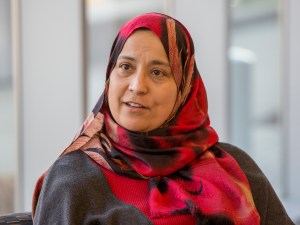Mary Winston Jackson (1921–2005) successfully overcame the barriers of segregation and gender bias to become a professional aerospace engineer and leader in ensuring equal opportunities for future generations.
Mary Jackson was born in Hampton, Virginia, and attended the all-black George P. Phenix Training School where she graduated with honors. She graduated from Hampton Institute (now Hampton University) in 1942 with a bachelor of science degree in both mathematics and physical sciences. In college, she became a member of Alpha Kappa Alpha, the first sorority founded by African-American women. After graduation, she accepted a teaching position at a black school in Calvert County, Maryland. She held several more positions including receptionist and bookkeeper, and was at home for a time following the birth of her son, before she accepted a position with the NACA Langley Aeronautical Laboratory’s segregated West Area Computers in 1951, where her supervisor was Dorothy Vaughan.
After two years in West Computing, Jackson was offered a computing position to work with engineer Kazimierz Czarnecki in the 4-foot by 4-foot Supersonic Pressure Tunnel. In addition to her computing tasks, Czarnecki offered her hands-on experience conducting experiments in the facility, and encouraged her to enter a training program that would allow her to earn a promotion from mathematician to engineer. Trainees had to take graduate-level math and physics in after-work courses managed by the University of Virginia. Because the classes were held at then-segregated Hampton High School, however, she needed special permission from the City of Hampton to join her white peers in the classroom. Never one to flinch in the face of a challenge, she requested and received permission to attend the classes. She completed the courses, earned the promotion, and in 1958 became NASA’s first African-American female engineer. Her engineering specialty was the extremely complex field of boundary layer effects on aerospace vehicle configurations at supersonic speeds. That same year, she co-authored her first report, “Effects of Nose Angle and Mach Number on Transition on Cones at Supersonic Speeds.” By 1975, she had authored or co-authored a total of 12 NACA and NASA technical publications.
In 1979, seeing that the glass ceiling was the rule, rather than the exception for Langley’s female professionals, she made a final, dramatic career change, leaving engineering and voluntarily accepting a reduction-in-grade to serve as an administrator in the Equal Opportunity Specialist field. After undergoing training at NASA Headquarters, she returned to Langley and filled the open position of Langley’s Federal Women’s Program Manager. There, she worked hard to impact the hiring and promotion of the next generation of all of NASA’s female mathematicians, engineers and scientists. Jackson retired from Langley in 1985.
Among her many honors were an Apollo Group Achievement Award, and being named Langley’s Volunteer of the Year in 1976. She served as the Chairperson for one of the Center’s annual United Way campaigns, was a Girl Scout troop leader for more than three decades, and a member of the National Technical Association (the oldest African American technical organization in the United States). She and her husband Levi had an open-door policy for young Langley recruits trying to gain their footing in a new town and a new career. A 1976 Langley Researcher profile might have done the best job capturing Mary Jackson’s spirit and character, calling her a “gentle lady, wife and mother, humanitarian and scientist.” For Mary Jackson, science and service went hand in hand.
The release of Margot Shetterly’s best-selling book “Hidden Figures” in 2016 and the hit motion picture of the same name in 2017 highlight the history of the West Computing Group and the careers of Mary Jackson and her peers Katherine Johnson and Dorothy Vaughan.
Mary Jackson passed away in Hampton on February 11, 2005, at the age of 83. She was preceded in death by her husband, Levi Jackson, Sr. and was survived by her son, Levi Jackson, Jr. and her daughter, Carolyn Marie Lewis.



























